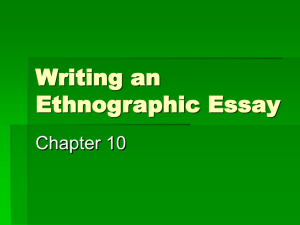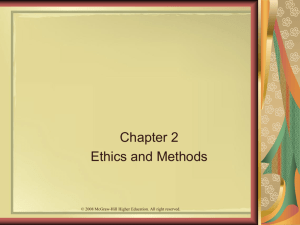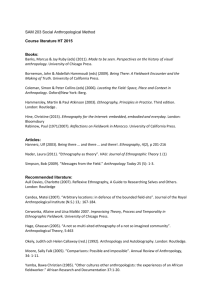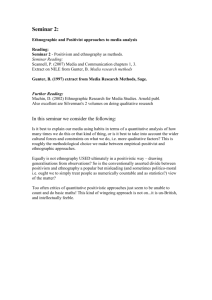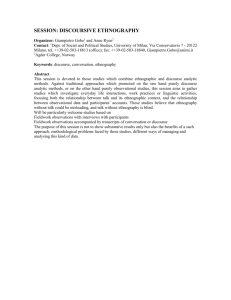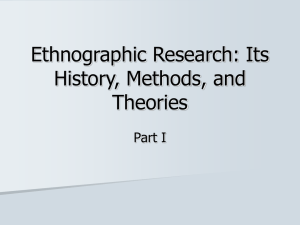Department of Anthropology Introduction to Social Cultural Anthropology Anthropology 101-010 Spring 2008
advertisement
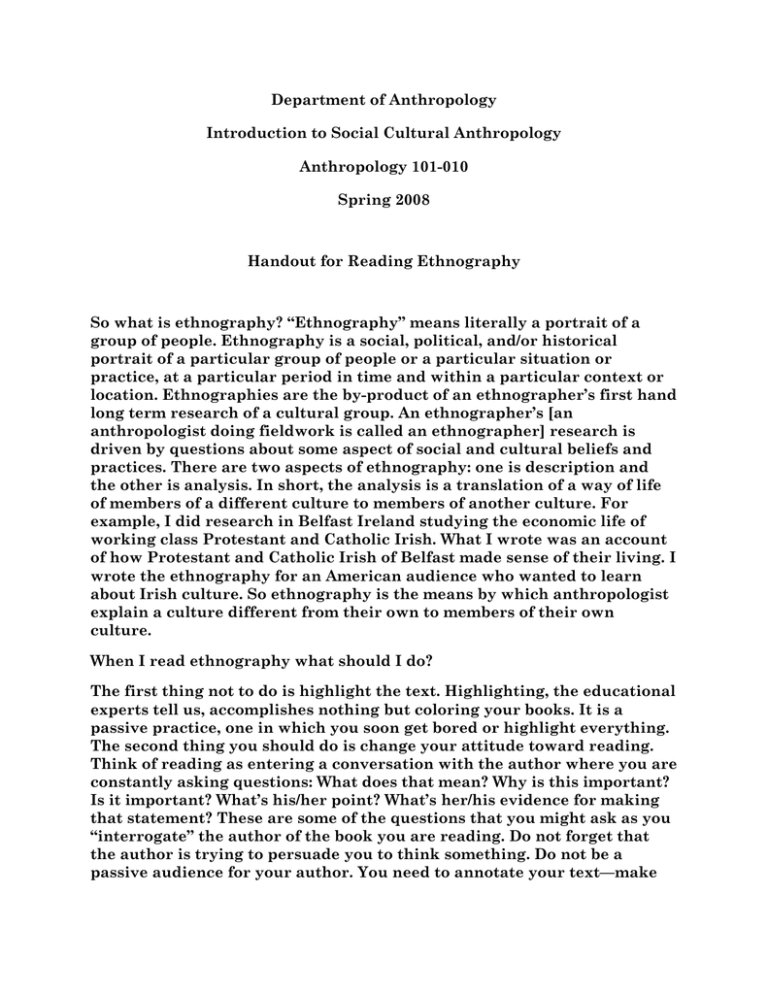
Department of Anthropology Introduction to Social Cultural Anthropology Anthropology 101-010 Spring 2008 Handout for Reading Ethnography So what is ethnography? “Ethnography” means literally a portrait of a group of people. Ethnography is a social, political, and/or historical portrait of a particular group of people or a particular situation or practice, at a particular period in time and within a particular context or location. Ethnographies are the by-product of an ethnographer’s first hand long term research of a cultural group. An ethnographer’s [an anthropologist doing fieldwork is called an ethnographer] research is driven by questions about some aspect of social and cultural beliefs and practices. There are two aspects of ethnography: one is description and the other is analysis. In short, the analysis is a translation of a way of life of members of a different culture to members of another culture. For example, I did research in Belfast Ireland studying the economic life of working class Protestant and Catholic Irish. What I wrote was an account of how Protestant and Catholic Irish of Belfast made sense of their living. I wrote the ethnography for an American audience who wanted to learn about Irish culture. So ethnography is the means by which anthropologist explain a culture different from their own to members of their own culture. When I read ethnography what should I do? The first thing not to do is highlight the text. Highlighting, the educational experts tell us, accomplishes nothing but coloring your books. It is a passive practice, one in which you soon get bored or highlight everything. The second thing you should do is change your attitude toward reading. Think of reading as entering a conversation with the author where you are constantly asking questions: What does that mean? Why is this important? Is it important? What’s his/her point? What’s her/his evidence for making that statement? These are some of the questions that you might ask as you “interrogate” the author of the book you are reading. Do not forget that the author is trying to persuade you to think something. Do not be a passive audience for your author. You need to annotate your text—make notes in the margin or on a separate piece of paper. Be sure to key your notes to the pages of your book. Anthropologist pursues knowledge by asking probing questions, such as: • • • • • • • • • • What counts as knowledge? What shapes any author’s—and audience—interpretation of ethnographic material? How do we address the role of subjectivity? How do ethnographers define their subjects and how do their inquiries reshape conceptions about the people they study? What does material have to look like in order for it to be deemed ethnographic? What is the role of theory in any given analysis and what politics shape the kind of theories we use? How do politics and political economy shape the production of anthropological knowledge? What goes into the creation of anthropological text/book? What constitutes an ethnographic text? What are the connections between ethnography, anthropology, political economy, imperialism, colonialism and the “rise” of the socalled west? Okay but are there particular questions I need to raise when reading ethnography? Yes and here they are: • • • • • • • • • • What is the author’s argument—what is the author’s main point or key points? What is the author arguing for and against? What is it that you are asked to accept on its face, as a basis of proceeding with the argument? Do you accept it? How would you characterize this text/book in ethnographic terms? What does the ethnography consist of? What do you think about that? How is the thesis supported by the ethnographic material used as evidence? Does the ethnographic material convince you of the argument? Is there any other way to interpret the material How would you characterize the ways that people are represented? Are there different conclusions to be drawn than the one(s) proffered by the author? The author focuses our attention on X. What would happen if we were to look instead through the lens of Y? What are the most interesting (problematic, revealing etc) insights that come out of either the ethnographic material or analysis of it? • • • • • In your view, what are the key questions raised by the text i.e., beyond what the author him or herself may have identified? How is theory used here? How does it inform analysis? Does this approach to the study of X have legs—in other words can it be applied in other situations? If so, why? If not, why? What, in the broadest sense, is the intervention this book is trying to make? What’s at stake in this mode of analysis: does the author mean to supplant other modes of understanding X or to supplement them? I’m sure I left something out. You may come up with your own questions.

